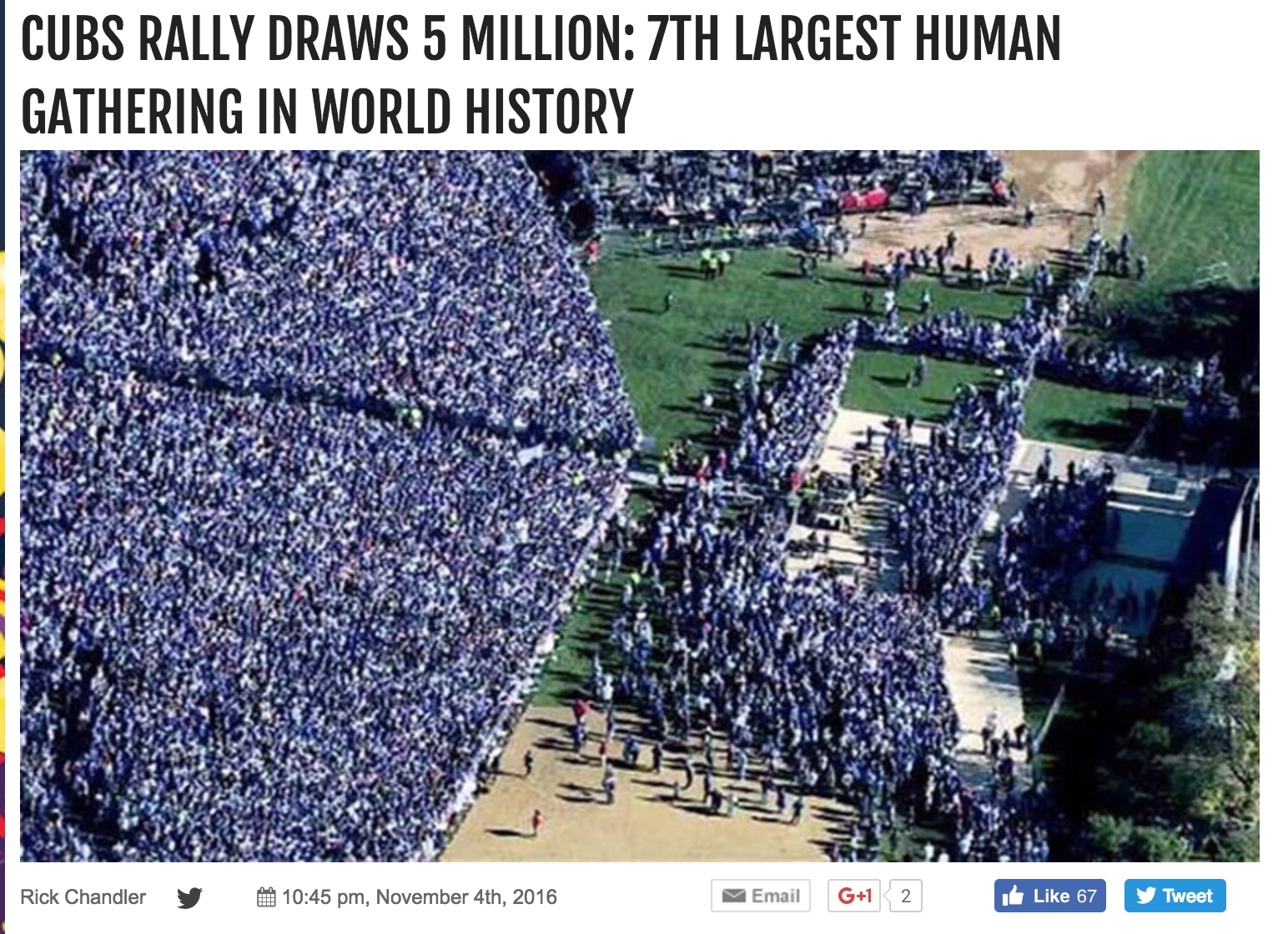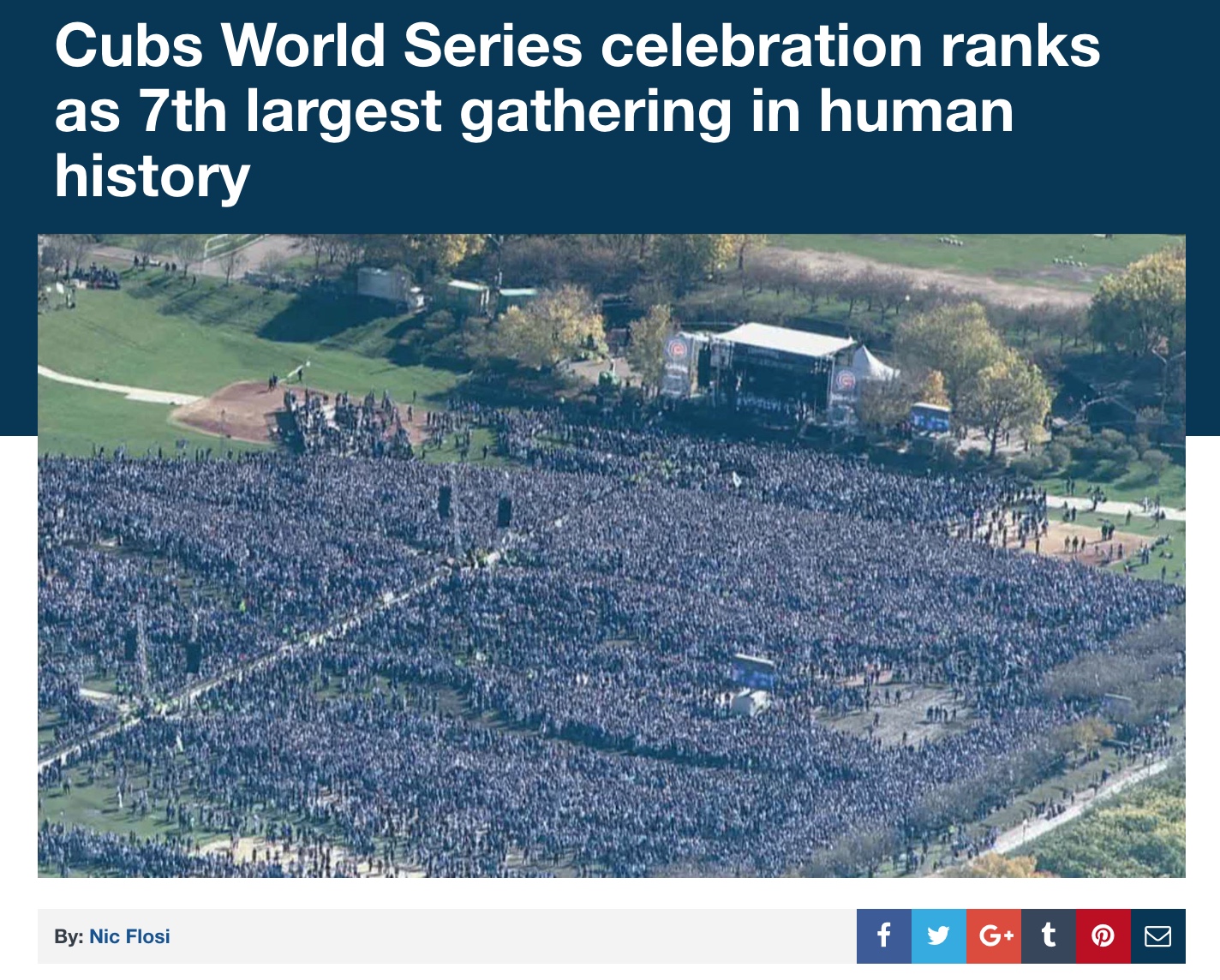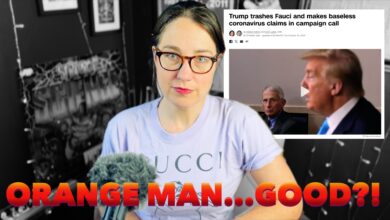Five Million Reasons the Cubs Crowd Estimates are Bogus

Not sure if you are all aware, but the Chicago Cubs just won the World Series. Apparently it’s a BFD. On Friday Chicago held a parade and rally downtown to celebrate. According to the city, five million human beings attended the events. The press has been breathlessly reporting on this number with not an ounce of skepticism.
However, if you even think about the implications of that many people converging into one spot, five million is an absurdly high number. There are only 2.7 million people who live in Chicago and just over five million in Cook County, the county that includes the City of Chicago and its surrounding suburbs. If five million people attended the Cubs celebration and most of them likely came from the Chicago area, then that means that almost every single person in Chicago and the Chicago suburbs attended the events, with some people who didn’t attend being offset by an equal number of tourists traveling in from outside the county. Although lots of locals did go to the festivities, it was hardly everyone.
There are lots of Cubs fans outside of the Chicago area who might have come in from a couple hours away for a long weekend, though. Maybe millions of people came in from out of town to attend the events. Where exactly did all these millions of people stay? The Chicago metro area has only around 100,000 hotel rooms, hardly enough for even a portion of the five million people who came to the city to celebrate the Cubs victory.
Let’s say that somehow there were five million people that live or found a place to stay in Chicago that went to the parade and rally. How did they all get downtown? Most of them likely took the El, Chicago’s subway system. Roughly 1000 people can fit on each eight-car train. If trains arrived downtown at a rate of two per minute, which seems reasonable, that means that 120,000 people could make it downtown each hour. If we assume a million people found a different method to get downtown, that means it would take 33 hours to transport all these people to the rally and parade locations. And, that’s just to get to the rally. At some point all these people will need to get out of the city, which means we’re looking at a second 33 hour period to transport all these people home. Although there were reports of people having to wait a couple hours for a Metra train to get home, it wasn’t even close to the over 30 hour waits that would have been expected had there actually been five million people attending the Cubs’ events.
In fact, the Chicago Transport Authority (CTA) said there were around 1.5 million riders on Chicago public transit on Friday. Assuming that everyone took two rides (one to get where they were going and one to get home), that’s only 750,000 passengers and many of these people were likely going to work or other places in the city, taking rides that had nothing to do with the Cubs rally. Even if we assume that every single passenger was going to the Cubs’ event, how did the other 4.3 million people get around the city on Friday?
Even if somehow five million people did find a place to stay and make it downtown for the events, how would all these people fit? I’ve been to large events like Lollapalooza at the section of Grant Park in Chicago that held the rally. With about 150,000 people it gets pretty full but you could fit a lot more if you had everyone really squish. 300,000 people is probably the limit of that area. Of course, a lot of people might have tried to get into that area and overflowed into other sections of the park. A very generous upper estimate of the number of people who could fit in and around the rally area is around 500,000. That’s probably a huge overestimate considering that photos posted of the event such as this one from Fox News show that people are clearly not packed in tight in the back of the area, but for the sake of argument, we’ll go with it anyways. That means that the rest of the 4.5 million people would have been along the parade route.
The parade route was six miles long, which means you’d be looking at 375,000 people on each side of the route for each mile. Assuming each person took up a 2ft by 2ft square, which is pretty tight, there would be crowds of spectators around 140 persons deep on each side of the parade route for the entire parade route. This is patently absurd. The sidewalk is only so wide. In most locations it would not be possible to fit this many people, causing most people to spill out into the intersections. The areas with the intersections would have people going back many thousands of people. Although by the time the parade got downtown, there were some intersections that looked a bit like this, it certainly wasn’t that way for the entire parade.
It’s completely ludicrous to claim that there were five million people at the Cubs celebration. A very generous estimate of the number of attendees would be around one million. The problem is that every time there is a big event in Chicago, the city claims that some preposterously large number of people attended, so the next time there is an event that seemed to be even bigger, they have to keep upping the claimed number of attendees. When the Blackhawks won the Stanley Cup last year, the city claimed two million people went to the celebration parade and rally, even though it was likely in the hundreds of thousands. Chicago even claimed 1.7 million people watched the Chicago marathon this year. As Chicago Tribune writer Mark Iris pointed out, that would mean that spectators would be packed in 12-18 people deep on both sides of the route for the entire 26.2 miles, which anyone who has run the Chicago marathon knows is clearly not the case.
Sure, a lot of people did come out to Chicago to celebrate the Cubs World Series victory this week, just not five million.
Featured image from Associated Press by Kiirchiro Sato









This reminded me of this classic from xkcd what-if: https://what-if.xkcd.com/8/
While I agree the number probably isn’t accurate. Chicagoland area is more than just cook county. Usually the agreed population of Chicagoland is in the 9million range
Even at 9 million, that would mean that 1 out of 2 people attended the parade.
My guess is they used the inflated numbers of the other parades in Chicago as a base. And, since nobody decided to debunk those numbers, then the city guesstimated how much larger this showing was than those previous showings. In other words…if you saw the White Sox parade and then saw this one…the eye test tells you this was probably about double the turnout of that. Since the city decided there were 2 million people or so at that event (and I don’t remember anybody really blinking too much at that estimate) then they went a bit more than double that for this…and rounded up to try and sound impressive.
Not here to argue, but give some possibilities of where people could have come from and stayed. I live in a small iowa town between Des Moines and Iowa City. I know of 17 residents who attended the parade. My son and I stayed in a hotel in Downers Grove. 5 stayed at family members houses in the northern suburbs, while the other 10 stayed at a family vacation home in Michigan City.
The space arguments make more sense than the “where did they come from” arguments. There are cubs fans willing to travel for their team that are well outside of Chicagoland.